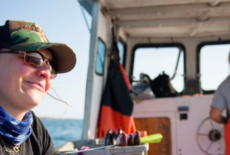Our Senior Citizens Are Suffering A Loneliness Epidemic–Can VR Be The Cure?
Published December 15, 2016 on Fast Company
Ninety-two-year-old Estelle Paris has never been to France, but on a warm day this past June, she slipped on a virtual reality headset, which allowed her to meander through streets by the Louvre, pop over to Mont Saint-Michel abbey 230 miles away, stop by Times Square in New York City, and journey underwater, just for a few minutes, to see some dolphins up close. Before taking off the headset and returning to her room at Neville Place assisted living facility in Cambridge, Massachusetts, Paris also visited her childhood home in Buffalo, New York–a place she moved away from around age 10–and virtually “walked” up and down her street by tapping a button on the side of the headset.
“It looks a whole lot different, but that house here, that looks familiar,” she says. “When I think of Buffalo, I think of snow. People didn’t ordinarily shovel their walks, the way they do in Boston.”
If the world seems like a lonely place to you these days, science confirms you’re right. A 2006 study conducted by scientists from Duke University and the University of Arizona examined how social networks and social isolation changed between 1985 and 2004 by looking at two separate population samples. While researchers anticipated that the two populations would have core social networks of roughly the same size, they found that network sizes shrank by about 30%. Most disturbingly, the number of Americans who reported having only one (or no) contacts they would feel comfortable sharing personal matters with increased from about 25% of the population to nearly half, a sharp increase researchers thought might be partially due to societal shifts away from activities that foster community or neighborhood ties. Fast forward a few years, and despite the many socially connective technologies that have arisen in the interceding time, loneliness is still a widespread problem that affects one in three Americans over age 45 and nearly half of those over age 60.
To combat this, Rendever, a Boston-based startup dedicated to reducing loneliness and improving mental health among the elderly through virtual reality experiences, is beta-testing a new virtual reality experience with senior citizens like Paris. Launched last year by MIT business students Dennis Lally and Reed Hayes, the company offers more than 100 virtual “bucket list” experiences, ranging from museum visits to sky diving excursions to canoe rides through the Grand Canyon, all projected from a smartphone through a virtual reality headset. The company’s VR system also connects to Google Street View, allowing users to see three-dimensional views of any place of personal importance and hopefully spark conversations that wouldn’t happen without virtual prompting in the process.
“If you put people in new environments, what we’ve seen is they want to talk about it. They want to share their new experiences with each other and say, ‘This is what I just did’ or ‘This is where I grew up. I want to show you this,’” says Lally, adding that preliminary data shows that users report more than a 30% increase in happiness, on average, immediately after using the system.
In the coming months, Rendever plans to roll out a subscription system for eldercare and assisted living facilities that would provide headsets and virtual reality modules for a to-be-decided fee of “a few hundred a month,” says Lally. The subscription would also include a set of cameras families could use to film their own special events, which could then be uploaded and viewed by residents in VR.
If strapping a virtual realty headset onto your grandparents and letting them roam through pixelated landscapes sounds strange now, it may not be in the future. One Caring Team, a company based in San Carlos, California, is also creating virtual environments for anyone with limited mobility, including the elderly and those with debilitating diseases, in an effort to improve patient quality of life. Packaged as part of a larger menu of services designed to support caregivers and those they care for, the company’s Aloha VR program launched last year offers virtual experiences that range from static scenes–users can look around a digital island paradise for example–to more interactive experiences for alert patients. One Caring Team doesn’t focus exclusively on the elderly, but like Rendever, one of their goals is to reduce the impact of loneliness, a condition researchers are discovering takes a much larger physical and mental toll than previously thought.
MIT postdoc Gillian Matthews accidentally finds herself on the forefront of uncovering the neurological foundation of loneliness and how our brains are wired for social connectivity. Back in 2011, while earning her neuroscience PhD at Imperial College London, Matthews began studying how cocaine impacts the brain. She was especially interested in a clump of cells called the dorsal raphe nucleus (DRN) that manufactures two neurotransmitters–serotonin and dopamine, which are both linked to mood regulation, motivation, and drive. Anticipating that cocaine would increase the strength of neural connections in the DRN, indicating that this region of the brain is linked to the body’s response to addictive drugs, Matthews injected rodents with either cocaine or saline and isolated each mouse for 24 hours. When she looked at how each mouse’s brain reacted, she was surprised to find that both groups showed strengthened neural connections in their DRNs.
“Our first thought was that maybe we mixed up syringes, that we were actually giving cocaine to both groups,” says Matthews.
After ruling out mix-ups, Matthews began to think about the possibility that the strengthened connections were invoked by something other than cocaine. She began to look at if the isolation period all mice were subjected to might be the cause. Using optogenetics–a process that involves inserting light probes into live mice to allow researchers to stimulate or inhibit brain neurons in real time–Matthews and MIT neuroscientist Kay Tye conducted a series of experiments and found that mice hated having their DRNs stimulated, avoiding it when possible. They also found that when the DRN was stimulated, mice were motivated to seek out rodent companionship.
“Even though it seemed to produce an unpleasant state, it also seemed to promote sociability,” says Matthews, leading her to believe that the strengthened DRN connections might be related to loneliness, an unpleasant state that is often relieved by the company of others. Strengthened DRN neural connections also correlated with where mice fell in the social hierarchy. Dominant mice–who (presumably) had stronger or more highly valued social relationships–showed stronger DRN neural connections than subordinate animals with fewer or weaker social relationships.
This past February, Matthews and Tye (alongside collaborators from MIT and Imperial College London) published what Matthews believes is the first scientific paper detailing the chemical and cellular substrates of loneliness. Some experts believe this research supports theories that the drive to avoid feeling isolated is a fundamental part of our being, as powerful and important as other evolutionary drives like the need to have shelter, though Matthews says that significant research would need to be conducted across multiple species to confirm those theories.
It’s unclear exactly how effective virtual reality interventions will be in fighting loneliness, but the need for interventions–high tech or otherwise–is bolstered by evidence of how widespread loneliness is and the physical toll it takes, especially on the elderly. At any given time, 6% to 7% of the general population experiences symptoms of depression–a condition that goes hand-in-hand with loneliness–but in long-term eldercare facilities, those figures shoot up to 20% to 37% . Dennis Lally from Rendever believes that those figures are low, since depression often goes undiagnosed in nursing home settings.
“People go into these communities and they’re just not getting the new experiences that they used to get when they would leave their homes and go run errands, travel the world, whatever it may be,” Lally says, adding that virtual reality can potentially fill in some of those gaps. “They also lose their social connections . . . it really creates this feeling of isolation.”
Loneliness evokes more than just bad feelings; some evidence shows it creates physical pain, too. In 2003, Naomi Eisenberger, now director of UCLA’s Social and Affective Neuroscience Laboratory, connected students to fMRI and watched as they played a video game that involved tossing a digital bal6l between two other players supposedly located in different labs. At some point in game play, the other players–who never actually existed–began playing among themselves, excluding the live player being observed by Eisenberger’s team. Eisenberger found that the brain regions that were activated when players felt excluded overlapped heavily with the regions activated when people are in physical pain. A paper she coauthored in 2010 took the research even further, revealing that acetaminophen–the painkiller found in Tylenol and Anacin–not only alleviated physical ails, it also reduced feelings of rejection and social pain.
The social-physical pain connection “sort of gives an explanation for why people talk about, ‘Oh rejection hurts,’ and we talk about heartbreak,” Eisenberger says. “To the extent that the brain is processing social rejection very similarly to physical pain, it makes sense why we use pain-related language when we talk about these negative social experiences.”
Loneliness is also dangerous to both health and lifespan, making it even more important for eldercare providers to be ready to prevent and treat the condition.
“Lacking social connection carries a similar risk to smoking up to 15 cigarettes per day,” says Julianne Holt-Lunstad, a professor of psychology and neuroscience at Brigham Young University who has spent more than 15 years studying the health impacts of loneliness and has published two major meta-analyses of research in the field. The first, published in 2010, analyzed 148 different studies and found that people with weak social connections had a higher mortality risk than those with obesity. The second meta-analysis, published five years later, focused more directly on social isolation and loneliness, concluding that the pair are so closely linked to shortened lifespan, they should be considered public health concerns.
“Having people around can encourage us to eat better, get more sleep, go see a doctor when we need to, and encourage us to take our medication,” says Holt-Lunstad. “Our relationships also provide a sense of meaning and purpose in our lives . . . All of these things can contribute to overall risk or protection depending on what end of the spectrum you’re on.”
Whether virtual reality can effectively mitigate loneliness in the long term isn’t known, but there is a wide body of research showing that VR, with oversight from medical professionals, can be used to treat conditions ranging from post-traumatic stress disorder to phobias. There is no gold standard for loneliness intervention , but Lally is confident that VR can help.
“We’ve brought some of the residents to tears just out of enjoyment,” he says. “They’re just so happy to see a new experience, to be in a new place outside of the 5,000 square feet that they’re confined to.”
Rendever and One Caring Team’s virtual reality projects aren’t the only efforts to stem the loneliness tide. The French social network Voisin-Age provides a platform that connects elderly people with their neighbors, while retirement facilities like Judson Manor in Cleveland, Ohio, allow music students to live rent-free if they perform for elderly residents.
The United Kingdom’s Campaign to End Loneliness attacks the problem on a larger level. The nonprofit group partners with about 1,000 organizations throughout the U.K. to mobilize community action to tackle the loneliness problem and push the issue as a local and national public health priority. Developing effective intervention strategies isn’t easy, says Catherine McClen, a campaign ambassador and founder of BuddyHub, a website that creates social networks for older people by matching them with like-minded people in their area.
“Loneliness is a very individual problem. It’s a very personal problem and no two people are the same,” says McClen. “There can be lots of solutions out there, but one size will never fit all. The more options that are available to people, the better.”
Virtual reality could provide one option for reducing loneliness, but an easier way could be to simply anticipate the condition before it happens.
“Part of planning for retirement should be planning, not just financially but planning socially, given that there are many social disruptions around the time of retirement,” says Julianne Holt-Lunstad. “Planning for that well in advance and [taking steps for] prevention may be some of the best tools that we can consider.”
Disclosure: The author works for MIT in a different department and had no connection to any MIT affiliated sources prior to this interview.






